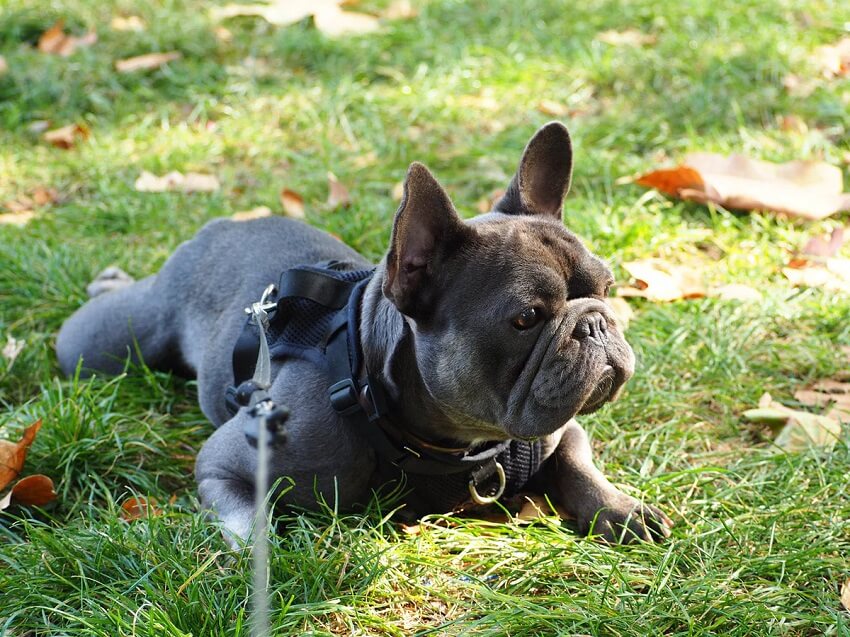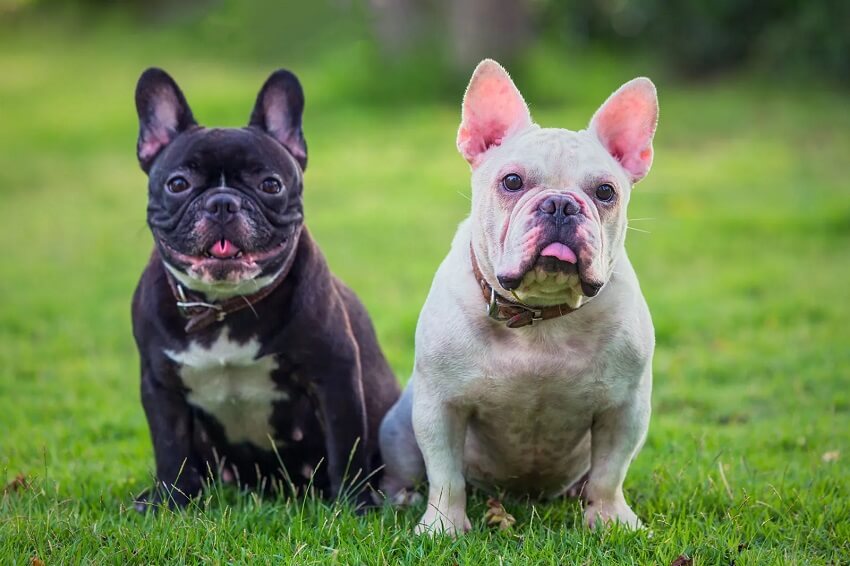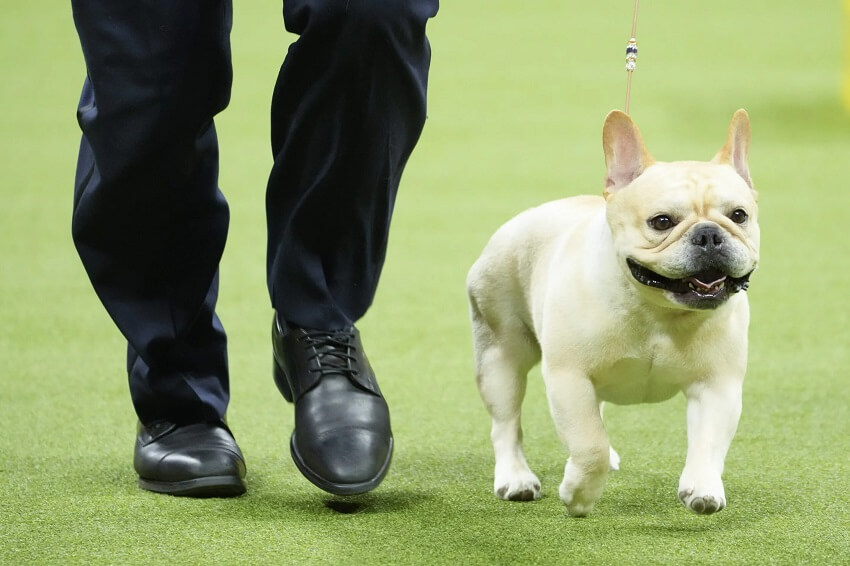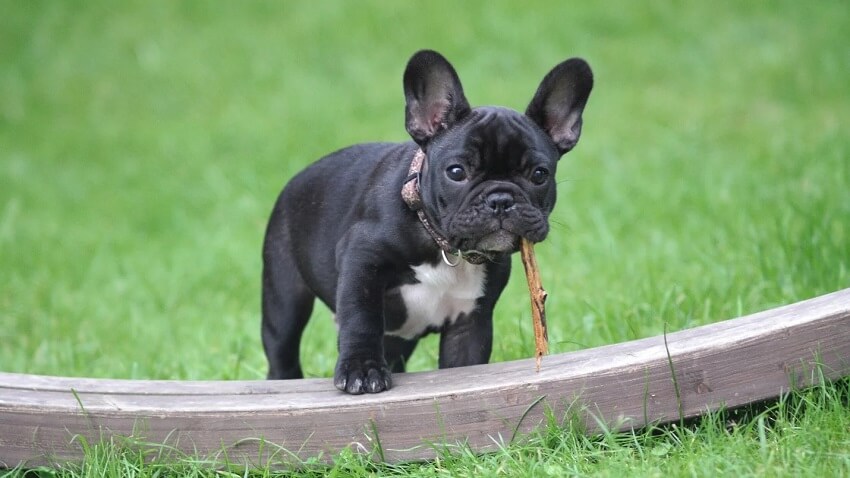This document provides a guide to evaluating purebred French Bulldogs, based on the FCI breed standard. The French Bulldog ranks as the 4th most popular dog breed in the UK and the US, and 6th globally according to the AKC. We hope this article from Know All Animals offers a comprehensive overview of the French Bulldog and provides the knowledge you need to select a puppy. This guide will help you gain experience and understand standard pricing when buying or selling a French Bulldog.
French Bulldog Breed Overview
- Group: Non-Sporting
- Size: Small, weighing 7-13 kg (15-28 lbs) and measuring 28-33 cm (11-13 inches) in height.
- Coat: Short, smooth, with minimal shedding.
- Coat Colors: Brindle, fawn, white, brindle-and-white, fawn-and-white. Rare colors include lilac, blue, and merle.
- Lifespan: 10-12 years.
- Temperament: Playful, friendly, loyal, and affectionate.
- Exercise Needs: Low. They only require short walks and light play.
- Training: Intelligent but can be stubborn at times. Positive reinforcement methods are recommended.
- Grooming: Minimal. The coat only requires occasional brushing.
- Health Issues: Prone to respiratory problems, overheating, and eye conditions.
- Litter Size: 2-4 puppies. Natural birth is very difficult, and C-sections are often required.

1. The Origins of the French Bulldog
Despite its name, the French Bulldog actually originated in England in the early 19th century, not France. In the Nottingham region, lacemakers bred the larger English Bulldog down to a smaller, more manageable version called the Toy Bulldog. This breed weighed around 5-11 kg, maintaining its muscular build in a compact size, a key trait of larger bulldogs.
The original English Bulldog was used for the brutal sport of bull-baiting, where dogs would attack bulls by biting their noses. However, the Cruelty to Animals Act of 1835 outlawed this practice. As a result, bulldogs were no longer used for fighting and transitioned into being companion and family dogs.
2. Appearance and Temperament of the French Bulldog
French Bulldogs are small, muscular dogs known for their friendly nature and distinctive look. Their unique appearance includes rare color variations that are highly sought after. Here’s a detailed overview of the breed:
2.1 Key Physical Characteristics
- Height: 28-31 cm (11-12 inches).
- Weight: Males weigh 20-28 kg (44-62 lbs), while females weigh 16-24 kg (35-53 lbs).
- Body: Muscular with short legs, a large head, and numerous wrinkles.
- Ears: Erect and bat-like.
- Eyes: Large, round, and dark (some rare colors have blue eyes).
- Coat: Short and smooth, making it easy to care for with minimal shedding. Regular brushing is all that’s needed to keep their coat clean and shiny.
Coat Colors and Patterns:
- Common Colors: Cream, white, fawn, brindle, and piebald (black and white).
Rare Colors:
- Blue: A gray-blue shade caused by a dilute gene.
- Lilac: A grayish-pink hue, resulting from a combination of the blue and chocolate genes.
- Merle: A patchy, mottled coat pattern caused by the merle gene.
- Isabella: A light brown-gray color, also a result of the blue and chocolate genes.
These rare colors like blue, lilac, merle, and isabella often come with a higher price tag due to their uniqueness and scarcity.

2.2 French Bulldog Temperament and Behavior
French Bulldogs are beloved not only for their cute appearance but also for their friendly and cheerful personalities. Here is an overview of this breed’s typical temperament and behavior:
Friendly and Affectionate
French Bulldogs are extremely friendly, especially with children. They love being close to their owners and tend to follow them around the house. They can be prone to separation anxiety if left alone for too long.
Playful and Humorous
Known for their comical nature, French Bulldogs often entertain their families with their silly antics. They love to play and make excellent companions.
Intelligent but Stubborn
While intelligent and capable of being trained, they can also be stubborn, especially if not motivated properly. Positive reinforcement training methods are most effective with this breed.
Quiet and Not Prone to Barking
French Bulldogs are not excessive barkers, making them ideal for apartment living or quiet neighborhoods. They are also generally friendly with strangers and make new friends quickly.
Independent but Needing Attention
Despite their clingy side, they have an independent streak and can entertain themselves. However, they still need plenty of attention and should not be left alone for extended periods.
Highly Adaptable
They adapt well to various living situations, from small apartments to houses with yards. French Bulldogs don’t require a lot of space for exercise, making them perfectly suited for urban life.
Gets Along with Other Pets
With early socialization, French Bulldogs can get along well with other pets like dogs and cats, creating a harmonious and happy household.
The French Bulldog is a compact, playful, and friendly dog, ideal for families with children or those living in the city. While they can be a bit stubborn at times, with the right training and care, a French Bulldog will be a loving and fun member of your family.
3. French Bulldog Living Environment
French Bulldogs are quiet dogs that prefer a calm environment. They are well-suited for apartment living in urban areas, as they don’t bark much and are happy to relax indoors. They are very friendly with people, especially children, and can coexist peacefully with other pets. Their low-maintenance coat makes them an excellent choice for busy professionals who don’t have a lot of time for grooming.
French Bulldog Evaluation Standards:
- Affectionate with Family: 40%
- Tendency to Bark: 40%
- Shedding Level: 10%
- Odor Level: 60%
- Ease of Grooming: 10%
- Good with Kids: 40%
- Good with Other Animals: 40%
- Exercise Needs: 20%
- Trainability: 60%
- Drooling Level: 40%
- Cold Tolerance: 80%
- Heat Tolerance: 20%
4. Classifying French Bulldogs
French Bulldogs can be categorized in several ways, from purebred to unique hybrid variations:
- Purebred: These dogs meet the official standards for appearance and health set by kennel clubs like the AKC.
- Mixed Breeds: Popular hybrids include the Frug, Frenchton, and Bullweiler, among many others.
- Fluffy French Bulldog: A rare variant with a distinctive long, soft coat.
- Mini French Bulldog: These are smaller than the standard size, typically weighing under 20 lbs. However, they are often more prone to health issues.

5. Popular French Bulldog Mixes
French Bulldogs are often bred with other popular breeds, creating unique and beloved hybrid dogs:
- Frug: A mix of a Pug and a French Bulldog.
- Frenchton: A mix of a Boston Terrier and a French Bulldog.
- French Bullweiler: A mix of a Rottweiler and a French Bulldog.
- Bullmatian: A mix of a Dalmatian and a French Bulldog.
- French Bull Tzu: A mix of a Shih Tzu and a French Bulldog.
- Bull Jack: A mix of a Jack Russell and a French Bulldog.
- French Boodle: A mix of a Poodle and a French Bulldog.
- French Bullpei: A mix of a Shar Pei and a French Bulldog.
- French Chow: A mix of a Chow Chow and a French Bulldog.
- Frenchie Staff: A mix of an American Staffordshire Terrier and a French Bulldog.
The French Bulldog’s appeal lies not only in its charming appearance but also in the diversity of its colors and the wide range of popular mixed breeds. From purebreds to playful mixes like the Frug and Frenchton, this breed remains a top choice for dog lovers everywhere.
6. Common Health Issues in French Bulldogs
Despite their sturdy appearance, French Bulldogs are prone to several common health problems:
- Obesity: French Bulldogs have a hearty appetite and a love for food that’s rich in protein and carbohydrates. Combined with their low energy levels, this can easily lead to obesity if their diet and exercise aren’t carefully managed. To prevent this, it’s crucial to establish a balanced diet and a consistent exercise routine.
- Respiratory Problems (Brachycephalic Syndrome): Due to their distinctive flat faces and short snouts (a result of close breeding), French Bulldogs are highly susceptible to respiratory issues. This can lead to frequent snoring and wheezing, and they can have difficulty breathing, especially in hot or humid weather.
- Skin Infections: French Bulldogs are prone to skin problems, which can be caused by an unclean living environment, parasites like fleas and ticks, or reactions to certain shampoos. These issues often manifest as red, inflamed skin and hair loss. Proper hygiene and using a vet-recommended shampoo are essential for prevention.
- Eye Conditions: This breed commonly suffers from various eye problems, including cherry eye, cataracts, conjunctivitis, and dry eye syndrome. These conditions can be genetic or caused by irritants like dust or pollen. Treatment varies depending on the specific issue, ranging from addressing the underlying allergen to using medicated eye drops.
7. Tips for Raising a French Bulldog
7.1. Feeding Your French Bulldog
French Bulldogs have simple dietary needs, and they can eat various foods. However, their playful and sometimes lazy nature means they might refuse to eat until they get very hungry. To keep them healthy, it’s essential to provide them with high-quality, protein-rich meals supplemented with fruits and vegetables to ensure they get all the necessary nutrients.
7.2. Training Your French Bulldog
French Bulldogs can be stubborn, so it’s best to start training them early, around three months of age. Begin by socializing them with their environment by taking them on walks to local parks and other dog-friendly areas.
Potty Training
When you see signs that your Frenchie needs to relieve itself, immediately take it outside to a designated spot. Alternatively, you can use puppy pads or newspapers indoors. With consistent training for 1-2 weeks, your dog will learn to go in the right place. When it’s successful, praise it enthusiastically to create a positive association.
Teaching “Sit”
Hold a treat your dog loves near its nose. As it tries to reach for the treat, it will instinctively jump up. Give the command “sit” and guide it into a sitting position. Once it sits, reward it with the treat. Repeat this process until it learns to sit on command.
Teaching “Down”
After your dog has mastered the “sit” command, you can teach it to lie down. Give the “down” command and gently press down on its shoulders while guiding its legs into a lying position.
Teaching “Shake Hands”
Have your dog sit. Give the command “shake hands” while using your left hand to lift its right paw. Reward it with a treat for a successful shake. Regular repetition will help it remember the command.
Teaching “Wait” (Mealtime Control)
Prepare your dog’s food in its bowl. As it rushes to eat, use a leash to gently pull it back and firmly say “wait.” Hold this position for about two minutes, then give the command “eat” to release it. With consistent practice, your Frenchie will learn to wait for your command before eating.

8. French Bulldog Pricing: How Much Do They Cost?
The price of a French Bulldog varies depending on its origin and lineage. Here is a general price guide:
- French Bulldogs bred in Australia typically range from $229 to $420 USD. These are purebred dogs with complete ownership and origin papers from reputable breeders.
- French Bulldogs imported from Thailand usually cost between $688 and $955 USD, including all necessary documentation.
- French Bulldogs imported from Europe are the most expensive, priced from $1,719 to $2,673 USD. These dogs come with full pedigree and ancestry documents.
When it comes to colors, rare varieties like lilac, blue, merle, and Isabella are the most expensive due to their scarcity and unique genetics.
9. Frequently Asked Questions About French Bulldogs
How do I tell the difference between a French Bulldog and a Boston Terrier?
French Bulldogs have short, thick legs, a stocky, muscular body, and deep wrinkles on their face.
Boston Terriers have a slimmer body with longer, thinner legs. Their cheeks and forehead typically have fewer wrinkles.
Are French Bulldogs picky eaters?
No, French Bulldogs are not picky and can eat a wide variety of foods. However, they particularly enjoy meat, as their digestive system is optimized to absorb nutrients from animal protein. Their diet should be rich in protein and fiber to provide the energy they need.
Are French Bulldogs friendly?
Despite their endearing and lively personalities, their wrinkled faces and flat noses can sometimes make them appear intimidating to people who are meeting them for the first time. In reality, French Bulldogs are known for being very friendly, easygoing, and sociable.
This article from Know All Animals provides a comprehensive overview of the French Bulldog’s origins, characteristics, and pricing. We hope this information helps you in caring for your furry friend.
References: https://en.wikipedia.org/wiki/French_Bulldog



